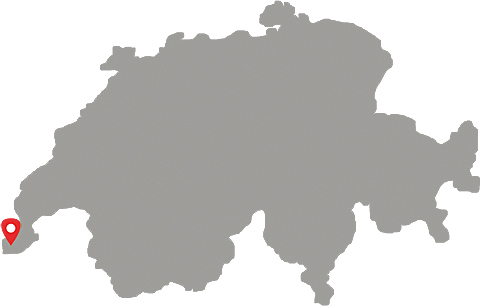The enclave of winegrowing villages of Le Mandement, bounded by the Rhone one way and the border with France the other, retain a delightful, rural, old-world appeal that seems light-years away from the cool sophistication of the city of Geneva, barely 20 kilometres distant. The occasional Auberge du Village or Café des Amis serves homemade soup and local longeole sausages in simple surroundings; a venerable wine board hanging on the wall lists simply Vin Blanc (Chasselas, Aligoté and Pinot Blanc) and Vin Rouge (Gamay and Pinot Noir), available in varying sizes of glass or jug.
The rural appeal remains, along with a few village cafés. What has changed beyond recognition are the wines. Emilienne Hutin of the eponymous family domaine in Dardagny talks of “la revolution viticole genevoise des années 80”: the revolution in Geneva’s winegrowing that started in the 1980s, provoked by disastrous overproduction and dismal quality. Those were turbulent times – “but it showed us that we needed to find new ways and forced us to get our act together, both viticulturally and commercially”. The new ways included elements such as halving of yields, regular monitoring of the grapes throughout their journey from the vineyard to the cellar and more responsive timing of the grape harvest.
Emilienne’s father Jean, still active at the domaine, was in the vanguard of this quality imperative, assisted by the similarly farsighted cantonal oenologist of the day, as well as Jean’s brother Pierre. The Mandement sub-region in general and Dardagny in particular has always had a nucleus of small, independent winegrowers who managed to maintain a presence apart from the cooperative movement, which formerly vinified the great majority of grapes grown in the region. This gave them mutual solidarity, pride in their independence and strength in – albeit small – numbers.
Small growers like Les Hutins inspire great fidelity amongst their customers, many of whom date back at least 30 years. They have followed the estate’s fortunes ever since the “revolutionary days” and continue to arrive on Friday evenings and Saturday mornings to catch up on the latest developments, to rejoice with the family at news of the domaine’s latest awards and prizes, and to stock up the wine cellar. Once, recalls Emilienne with evident amusement, she received a request from a small group who announced their arrival by helicopter. Concerned first where the chopper would land, she then agonised about how they would react to the Les Hutins tasting set-up – in the cellar seated at trestle tables surrounded by barrels, hoses and bottling apparatus. She needn’t have worried; they loved it, visibly relishing the contrast between their (presumably rarefied) everyday existence and this encounter with real winemaking in real surroundings.
Authentic wines made in a series of simple working spaces in the heart of a small farming village and a warm, unfussy welcome – these are what make a visit here so worthwhile. Their vineyards – around 20 hectares of them dotted around Dardagny – are moving steadily towards biodynamics. While Emilienne is painfully aware of the shortfalls of conventional viticulture with its reliance on chemical solutions, she is nevertheless realistic about the challenges of fully embracing biodynamics. They have been trialling plots all around the estate for many years – “it’s in constant evolution” – but for the moment she describes biodynamics as “un idéal absolu”.
It’s a dilemma shared by many ecologically minded winegrowers who would love to banish chemicals but who nevertheless cannot afford the luxury of losing large chunks of their harvest to diseases or pests. For now, she prefers a pragmatic approach which reduces chemical input to the bare minimum (including copper, permitted in both organics and biodynamics), while allowing her to produce authentic, carefully made, distinctive wines that she can sell at prices people are prepared to pay.
Emilienne now makes around 25 different wines from 16 different grape varieties, with prices ranging from around 10 to 30 francs (“something for all tastes and budgets”), each adorned with its own distinctive, funky-crazy, artist-designed label. Chasselas is still present – impossible to imagine a Geneva grower without it – but it has been greatly reduced in favour of Chardonnay, Pinot Gris and Sauvignon Blanc. “My grandfather adored Sancerre!” she says with a smile, adding that her dream is to make a wine like that. Of their two cuvées, one oaked and one not, it is the barrique version that is their wine in the Mémoire des Vins Suisses, to whose ranks Les Hutins were admitted in 2009. Another favourite is her fragrant, fully dry Savagnin Rose Aromatique (aka Gewurztraminer), which she prefers to label using its alternative name in order to avoid the exotic, obvious (and often sweet) connotations of Gewurztraminer.
Amongst the reds, for sheer originality and as a demonstration of how far Geneva has come from its all-Gamay days, I recommend Bertholier rouge, a savoury blend of Gamaret, Cabernet Sauvignon and Merlot. At the top of Emilienne’s range are the L’Intégrale wines, three reds (Pinot Noir, Merlot and Syrah), fermented and aged in small oak barrels. With such variety and quality, it’s clear that the truncated range of red and white wines on offer on those café wine boards is today but a distant memory.

|
ADDRESS: Chemin de Brive 8 1283 Dardagny CONTACT: Tel. 022 754 12 05 |
WINES TO LOOK OUT FOR: Chasselas Bertholier Sauvignon Blanc Barrique Savagnin Rose Aromatique (Gewurztraminer) Pinot Noir L’Intégrale Bertholier rouge |
|
info@domaineleshutins.ch |
|
|
Price range 10 to 30 SFr. |
|
|
HIGHLIGHTS: Visits welcomed Friday 5–6.30, Saturday 9–12 or by appointment. Wines may be ordered from the website. La Route du Vignoble vineyard trail around Dardagny |
|